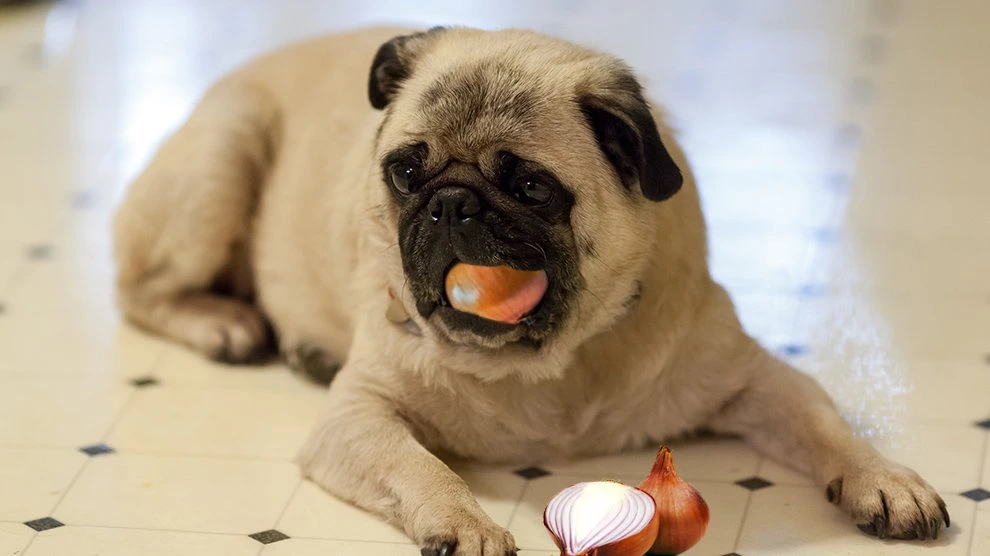No, dogs should not eat onions. Onions, along with other members of the allium family like garlic, leeks, and chives, are toxic to dogs and can cause serious health issues. Even small amounts of onions can lead to complications, depending on the size of the dog and the amount consumed. In this article, we’ll discuss why onions are harmful to dogs, what symptoms to watch out for, and what to do if your dog consumes onions.
Why Are Onions Toxic to Dogs?
Onions contain a compound called thiosulfate, which dogs are unable to digest properly. Thiosulfate damages a dog’s red blood cells, leading to a condition called hemolytic anemia. This can impair the dog’s ability to transport oxygen throughout their body, potentially resulting in serious health problems.
Key Toxic Components of Onions:
- Thiosulfate: Damages red blood cells and causes oxidative stress.
- N-propyl disulfide: Another sulfur-containing compound that contributes to the breakdown of red blood cells in dogs.
The toxicity applies to all parts of the onion—flesh, juice, leaves, and even processed forms like onion powder. Raw, cooked, fried, or dehydrated onions are all dangerous for dogs. Onion powder, which is often found in foods like soups, gravies, and processed treats, is particularly potent and can be harmful even in small amounts.
How Much Onion Is Toxic to Dogs?
Even small amounts of onion can be harmful to dogs. As a general rule, consuming more than 0.5% of a dog’s body weight in onions is considered toxic. For example, a dog weighing 20 pounds (9 kg) could be affected by as little as 1 ounce (28 grams) of onion, which is roughly equivalent to a small onion.
Since onion toxicity accumulates over time, frequent small doses may also be dangerous. If your dog regularly consumes small amounts of food containing onions (like table scraps or foods seasoned with onion powder), the toxins can build up and lead to anemia.
Symptoms of Onion Toxicity in Dogs
If a dog consumes onions, symptoms of poisoning may not appear immediately. They typically develop within 24 to 72 hours after ingestion. Here are some common signs of onion toxicity:
1. Lethargy and Weakness
One of the first signs of anemia caused by onion toxicity is fatigue. Your dog may seem unusually tired, weak, or reluctant to engage in normal activities like walking or playing.
2. Pale Gums
Pale or discolored gums are a clear sign of red blood cell damage. Healthy gums should be pink, but anemia can cause them to turn white or light gray.
3. Vomiting and Diarrhea
Gastrointestinal upset, including vomiting and diarrhea, may occur after a dog ingests onions. This is the body’s attempt to expel the toxin.
4. Breathing Difficulties
Dogs suffering from hemolytic anemia may experience difficulty breathing due to reduced oxygen levels in the blood. You may notice rapid or labored breathing.
5. Elevated Heart Rate
A faster-than-normal heart rate, or tachycardia, may occur as the heart works harder to compensate for the lack of oxygen in the blood.
6. Discolored Urine
Hemolytic anemia can cause hemoglobin to be released into the urine, turning it a dark red or brown color.
7. Fainting or Collapse
In severe cases, a dog may collapse or faint due to a lack of oxygen reaching vital organs.
What to Do if Your Dog Eats Onions
If you suspect your dog has eaten onions, it’s important to act quickly to prevent serious complications. Here’s what to do:
1. Call Your Veterinarian Immediately
Contact your vet as soon as possible. If the ingestion was recent (within an hour or two), your vet may induce vomiting to prevent the absorption of toxins. They may also administer activated charcoal to bind any remaining onion particles in the stomach.
2. Monitor for Symptoms
Keep an eye on your dog for signs of onion toxicity, especially if you’re unsure how much they consumed. Symptoms may take up to 72 hours to appear, so it’s important to monitor them closely during this period.
3. Seek Emergency Care
If your dog is showing any signs of onion poisoning—such as weakness, vomiting, or pale gums—take them to an emergency veterinary clinic immediately. Hemolytic anemia requires prompt medical attention and treatment.
4. Blood Tests and Treatment
Your vet will likely run blood tests to check for signs of hemolytic anemia. Treatment may involve IV fluids, medications to protect the red blood cells, and, in severe cases, a blood transfusion to replace the destroyed cells.
How to Prevent Onion Poisoning
1. Avoid Feeding Table Scraps
Many common human foods contain onions or onion powder, even in small amounts. Avoid feeding your dog table scraps, especially dishes like soups, stews, casseroles, or sauces, which may have hidden onions.
2. Check Ingredients in Processed Foods
Read ingredient labels carefully if you offer your dog commercial treats or human food. Onion powder is often used as a seasoning in processed foods, including chips, sauces, gravies, and packaged snacks.
3. Teach Your Dog to Avoid Unsafe Foods
Train your dog not to beg for food or steal food from the table or countertops. This helps minimize the risk of accidental ingestion of foods containing onions.
Takeaway Tips for Keeping Your Dog Safe from Onion Poisoning
- No Onions, Ever: Avoid feeding your dog any food that contains onions, including onion powder or cooked onions.
- Monitor Symptoms: If you suspect your dog has ingested onions, watch for signs of onion toxicity, such as lethargy, vomiting, and pale gums.
- Call Your Vet ASAP: In the event of onion ingestion, contact your vet immediately for guidance and treatment options.
- Avoid Processed Foods: Many processed foods contain onion powder, so always check labels before offering them to your dog.
- Be Cautious with Table Scraps: Human foods often contain onions or onion powder, so it’s best to avoid giving table scraps to your dog.
By being aware of the dangers of onions and other toxic foods, you can help keep your dog healthy and safe.


